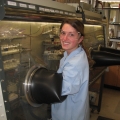
Homoleptic Organometallics
Homoleptic complexes are those in which only one type of ligand is bonded to the central metal atom. The high symmetry of these complexes typically allows for simplified spectroscopic characterization. We are using this property of homoleptics to analyze and understand the nature of the metal-ligand bond, especially for the actinides. Past targets include, U(CH2SiMe3)6, [ThPh6]2-, and [UMe6]2-. As a result of these studies, we have learned that 5f orbital involvement is relatively minor for Th(IV), but quite significant for U(VI). Ultimately, these finding will allow us to make better predictions about actinide behavior during spent nuclear fuel processing.
Publications
- Synthesis, structure and bonding of hexaphenyl thorium(iv): observation of a non-octahedral structure
- Comparison of the reactivity of 2-Li-C<sub>6</sub>H<sub>4</sub>CH<sub>2</sub>NMe<sub>2</sub> with MCl<sub>4</sub> (M=Th, U): isolation of a thorium aryl complex or a uranium benzyne complex
- A rare uranyl(VI)-alkyl ate complex [Li(DME)<sub>1.5</sub>]<sub>2</sub>[UO<sub>2</sub>(CH<sub>2</sub>SiMe<sub>3</sub>)<sub>4</sub>] and its comparison with a homoleptic uranium(VI)-hexaalkyl





